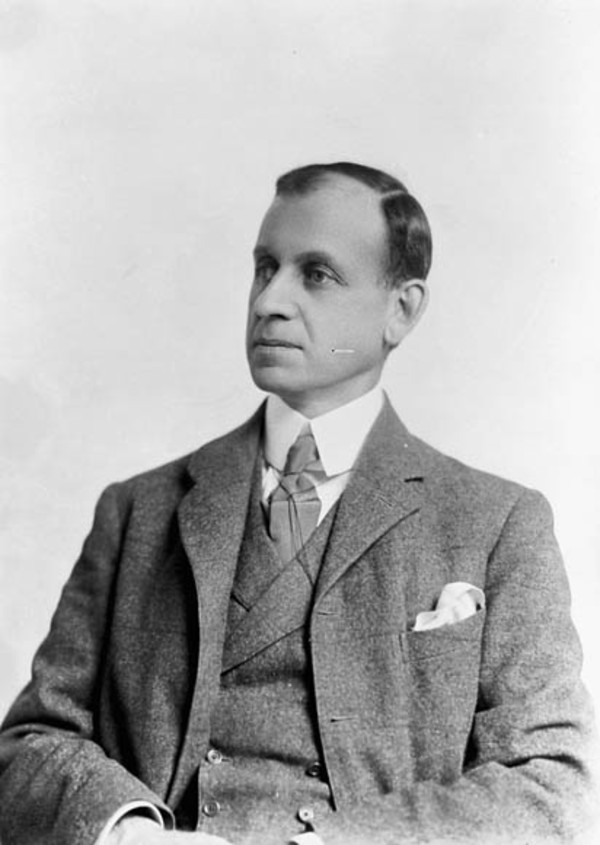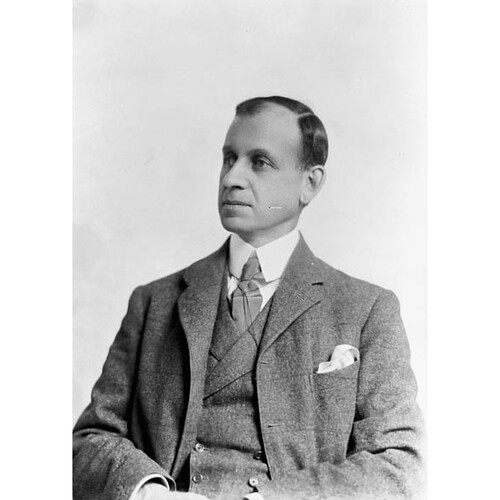
Source: Courtesy of Wikimedia Commons
Belcourt, Napoléon-Antoine (baptized Louis-Antoine-Ferdinand), lawyer and politician; b. 15 Sept. 1860 in Toronto, son of Ferdinand-Napoléon Belcourt and Marie-Anne (Marie-Anna) Clair; m. first 29 Jan. 1889 Hectorine Shehyn (d. 1901), daughter of Joseph Shehyn*, in Quebec City, and they had three daughters; m. secondly 19 Jan. 1903 Mary Margaret Haycock in Ottawa, and they had three sons as well as a daughter who died young; d. 7 Aug. 1932 at his country house on Lac Blue Sea, Que., and was buried in Notre-Dame Cemetery in Ottawa.
Napoléon-Antoine Belcourt was born in the summer of 1860 when his parents were living in Toronto, his father having gone there to take up a position as secretary-treasurer of the North-West Transportation, Navigation and Railway Company [see Allan Macdonell*] and later having joined the civil service of the Province of Canada. He attended the Séminaire de Saint-Joseph des Trois-Rivières and the law school at the Université Laval in Montreal, graduating summa cum laude in 1882. Called to the Quebec bar, he was drawn back to the province of his birth and was admitted to the bar there in 1884. In the same year he established an office in Ottawa, where he would practise law for the rest of his life. An early supporter of federal Liberal leader Wilfrid Laurier*, Belcourt first ran for the House of Commons in 1891 in the riding of Ottawa City but was defeated. In 1894 he founded a small newspaper, Le Temps, of which he was owner and editor for some years. Returned to the commons on his second attempt in 1896, he was re-elected in 1900 and 1904. That year he was made speaker of the house for the last (fourth) session of the ninth parliament; following the election for the tenth parliament in late 1904, a new speaker was chosen. In 1907 Laurier named him to the Senate.
According to his friend Charles Bruce Sissons*, Belcourt was “tall and spare, with the dignity befitting a former Speaker.” He was also a dour, private man. “He was ailing all his life,” remembered another friend, Raoul Dandurand*, “hemorrhages laid him low, and often he faced death.” Always concerned about issues of national unity, he was a traditional 19th-century Liberal. “The best government is the one that governs the least possible,” he argued, emphasizing “the need for more marked individualism, a greater spirit of private enterprise.”
Fluently bilingual, Belcourt was a tireless promoter of cooperation between religious and linguistic groups. His goodwill would be tested in two battles, over French-language schools in Ontario and Canadian participation in World War I. In 1908, aware of the increasing importance of the Franco-Ontarian community in the Ottawa valley, Robert Allan Pyne, minister of education in the provincial Conservative government of James Pliny Whitney*, asked Francis Walter Merchant, the chief inspector of public and separate schools, to report on the quality of education in the region’s French-language schools (known as bilingual or English-French schools because English had a major presence). Merchant concluded in early 1909 that the calibre of teaching was poor. The reaction of francophones in Ottawa was swift: they immediately took steps to organize a convention in January 1910 at which the provincewide Association Canadienne-Française d’Éducation d’Ontario (ACFEO) was created to defend French Canadian rights and improve bilingual schools [see Ovide-Arthur Rocque*]. Belcourt was elected its first president, a position he retained for two years. In 1912, prodded by complaints made by notable Irish Catholics such as Bishop Michael Francis Fallon of London, Whitney’s government issued Regulation 17, which limited the use of French as the language of instruction in Franco-Ontarian schools. When the Ottawa separate-school board refused to implement the directive, the succeeding government of William Howard Hearst* effectively put it in trusteeship in October 1914, intending to replace it with an appointed commission in 1915 [see Samuel McCallum Genest; Charles Hugh Gauthier*].
Some months earlier the schools issue had reached the Supreme Court of Ontario in the form of Mackell v. Ottawa Separate School Trustees (Robert Mackell was suing the trustees for not abiding by provincial law). Defending the Ottawa board, Belcourt took the occasion to seek redress from Regulation 17. In essence, he argued against the directive on three fronts. First, he maintained that the measure was effectively removing prerogatives established by the school regulations devised before 1867 in Upper Canada. Secondly, he contended that the right to speak French, and by implication the right to be instructed in it, was a natural right; he pointed out that Regulation 17 “constitutes the only attempt ever made in the British Empire to deprive British subjects of the use of their mother tongue.” Belcourt’s third position was that the regulation was “educationally speaking, an absurdity,” describing its reach as “manifestly a pedagogical heresy” and “utter nonsense,” given that students would have to be taught in a language they could not understand. The court was unmoved and in November 1914 found the school board guilty of disobeying the laws of the province. Belcourt quickly appealed its decision to its appellate division, but the Court of Appeal also found against the board in July 1915. Unhappy with these two setbacks, Belcourt decided to take his case to the Judicial Committee of the Privy Council in London.
He fostered public agitation as well. In early 1916 he triggered a campaign to encourage francophone residents not to pay their school taxes. His efforts were supported in February by a strike of bilingual teachers and by a march of 5,000 French Canadians to Parliament Hill, demanding federal intervention. (There is little doubt that Lionel Groulx* was inspired by Belcourt’s efforts to write L’appel de la race, a novel based on the defence of Franco-Ontarian rights.) In June, accompanied to England by Senator Philippe Landry*, Belcourt pleaded his case before the JCPC, repeating many of the arguments he had used in the past but adding two new ones: that article 133 of the British North America Act implied the right to teach in French where francophones requested it and that the school regulation attacked religious freedoms. In mid November 1916 the JCPC ruled Regulation 17 intra vires, but declared ultra vires the ousting of the Ottawa separate-school board. For Belcourt, there was at last some vindication. By finding that the province had no power to take over schools, the Privy Council effectively gave the board the tools to continue its fight.
Concerned about national unity, Belcourt had been exasperated by the conflict over Canada’s role in World War I. He was among the first prominent French Canadians to endorse enlistment (at a large public gathering in October 1914), supported the Canadian Patriotic Fund, and challenged those of Henri Bourassa*’s Nationalistes in Quebec who maintained that the country should not participate in the conflict. Belcourt personally would discover the conditions at the front on a fact-finding tour by members of the Empire Parliamentary Association in July 1916. The high point of the visit for him was a speech he gave in Paris on behalf of the delegation, in response to the welcoming words of the French president. In 1924 he would serve as minister plenipotentiary for Canada at the Inter-allied Conference on Reparations and Inter-allied Debts in London.
Following the war Belcourt set himself to harmonize the discordant voices in Canada’s politics. Named to a second term as president of the ACFEO in 1921, he was a co-founder that year of the Unity League of Ontario, a group of progressive anglophones, almost entirely Protestant, who were sympathetic to Franco-Ontarian aspirations. He also worked closely with Irish Catholic leaders in Ontario to heal the wounds of the education issue. After further representations to the provincial government by the ACFEO he had the satisfaction in 1927 of seeing the Conservative administration of George Howard Ferguson* adopt a more tolerant policy with regard to bilingual schools. Belcourt had finally won his case. He stepped down from the presidency of the ACFEO in 1930.
In the post-war period Belcourt had continued his dialogue with the Nationalistes, who on 24 May 1924 had awarded him the only Grand Prix d’Action française they would ever grant. In accepting the prize, he said, with typical modesty, that “it is to the Ontario minority that your congratulations are principally addressed.” From 1971 to 1983 he would be commemorated by a French Catholic high school in Ottawa, the École Secondaire Belcourt. The town of Belcourt, in the Abitibi region of Quebec, was named in his honour in 1958.
Napoléon-Antoine Belcourt is the author of a number of pamphlets, speeches, and articles, most of which relate to Franco-Ontarian rights and bilingualism and national unity in Canada. Among them is Regulation 17 ultra vires: argument of Hon. N. A. Belcourt before the Supreme Court of Ontario, November 2nd, 1914 ([Ottawa], 1914). A portrait of him by Charles Gill*, painted around 1905, hangs in the centre block of the Parliament Buildings in Ottawa.
Marilyn Barber, “The Ontario bilingual schools issue: sources of conflict,” CHR, 47 (1966): 227–48. Michel Bock, Quand la nation débordait les frontières: les minorités françaises dans la pensée de Lionel Groulx (Montréal, 2004). Robert Choquette, Language and religion: a history of English-French conflict in Ontario (Ottawa, 1975). P. A. Dutil, “Against isolationism: Napoléon Belcourt, French Canada, and ‘La grande guerre,’” in Canada and the First World War: essays in honour of Robert Craig Brown, ed. David MacKenzie (Toronto, 2005), 96–137. Gaétan Gervais, “Le Règlement XVII (1912–1927),” Rev. du Nouvel-Ontario (Sudbury, Ont.), 18 (1996): 123–92. Arthur Godbout, Nos écoles franco-ontariennes: histoire des écoles de langue française dans l’Ontario des origines du système scolaire (1841) jusqu’à nos jours (Ottawa, 1980). Lionel Groulx, L’appel de la race (Montréal, 1956) (trans. as The iron wedge by J. S. Wood, ed. and intro. Michel Gaulin (Ottawa, 1986)); L’enseignement français au Canada (2v., Montréal, 1931–33), 2. Mackell v. Ottawa Separate School Trustees (1914), Ontario Law Reports (Toronto), 32: 245–70. Nelson Michaud, “Les écoles d’Ontario ou le dilemme des conservateurs québécois: confrontation des principes nationalistes et de la réalité politique,” RHAF (Montréal), 49 (1995–96): 395–417. Rumilly, Hist. de la prov. de Québec, vol.18. C. B. Sissons, Bi-lingual schools in Canada, intro. J. S. Woodsworth (London and Toronto, 1917). Pellegrino Stagni, The view from Rome: Archbishop Stagni’s 1915 reports on the Ontario bilingual schools questions, trans. and intro. John Zucchi (Montreal and Kingston, Ont., 2002). G. M. Weir, The separate school question in Canada (Toronto, 1934).
Cite This Article
Patrice A. Dutil, “BELCOURT, NAPOLÉON-ANTOINE (baptized Louis-Antoine-Ferdinand),” in Dictionary of Canadian Biography, vol. 16, University of Toronto/Université Laval, 2003–, accessed January 1, 2026, https://www.biographi.ca/en/bio/belcourt_napoleon_antoine_16E.html.
The citation above shows the format for footnotes and endnotes according to the Chicago manual of style (16th edition). Information to be used in other citation formats:
| Permalink: | https://www.biographi.ca/en/bio/belcourt_napoleon_antoine_16E.html |
| Author of Article: | Patrice A. Dutil |
| Title of Article: | BELCOURT, NAPOLÉON-ANTOINE (baptized Louis-Antoine-Ferdinand) |
| Publication Name: | Dictionary of Canadian Biography, vol. 16 |
| Publisher: | University of Toronto/Université Laval |
| Year of publication: | 2016 |
| Year of revision: | 2016 |
| Access Date: | January 1, 2026 |



